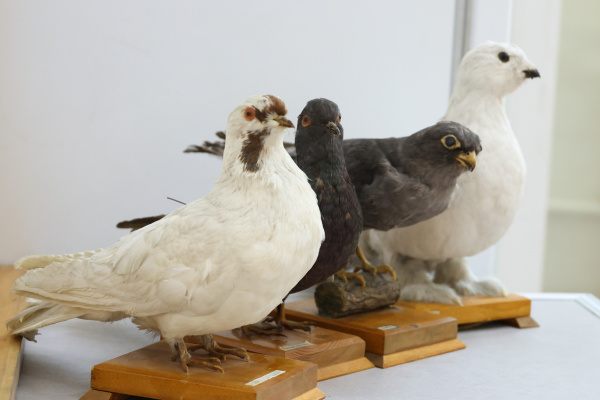December 20, 2024 | 10:21
Science
Education
New study on the role of migratory birds in the spread of diseases in Armenia
Currently, the world continues to face global health challenges, one of which is the spread of various diseases among humans and animals through migratory birds. An investigation into the role of migratory birds in the transmission of parasites and the spread of diseases in Armenia is being conducted by YSU PhD student Manan Asikyan.

The scientific project titled "The Role of Migratory Birds in the Spread of Certain Human and Animal Diseases in Armenia", authored by Manan Asikyan, a PhD student at the Chair of Zoology, YSU Faculty of Biology, has been awarded funding based on the results of the "Research Program for PhD Students and Young Researchers-2024" competition, announced by the Higher Education and Science Committee of the RA Ministry of Education, Science, Culture, and Sports (MoESCS).
It is well known that infections spread by birds can pose a significant threat to both humans and animals. In Armenia, however, there is a lack of comprehensive scientific research on the role of migratory birds in the spread of diseases, making this topic highly relevant. According to Manan, the scarcity of such studies underscores the importance of investigating this issue in depth to develop effective preventive measures in the future.
- Could you tell us about your research, the relevance of the topic, and your goals?

- In Armenia, while the species diversity and ecology of birds have been studied, their parasitic composition remains largely unexplored. The most recent data, published in 2020, dates back to 1990 and describes the nematodes found in 50 different bird species. While numerous global studies have been conducted on this subject, regional research is still lacking, highlighting the relevance of this topic.
Over 370 bird species are found in Armenia, with approximately 200 of them being migratory. The aim of this research is to investigate the role of migratory birds in the transmission and spread of parasites within the Republic of Armenia. Unlike mammals or reptiles, which face significant barriers when crossing borders, birds can migrate freely, with minimal geographic restrictions. This raises important questions: Where do birds migrate? Where do they come from? What diseases exist in the world? How might these diseases reach Armenia, and under what conditions could they be transmitted to humans?
To implement this project, we have selected three predetermined areas for study. In each of these regions, we will consider factors such as temperature, climate, and altitude. Apart from that, modeling will be conducted to determine in which regions of Armenia, under similar conditions, such a parasitic composition could be found in birds. Subsequently, we will model what the situation will look like a few years from now.
- Which birds can be a source of disease spread in Armenia?

- In general, all birds have the potential to be a source of disease spread, as there are no geographical boundaries for their movement. Being warm-blooded, birds are excellent reservoirs for parasites, viruses, and bacteria. For this study, we will primarily focus on passerines, which can be captured using our nets, as well as storks, which inhabit rural areas and are often close to human populations. Birds that can directly transmit diseases to humans are those that live in close proximity to people.
- How are diseases transmitted from birds to humans?
- Diseases that can be transmitted from birds to humans are known as zoonoses. They can be spread in two main ways: through direct contact with an infected bird, or via infectious bacteria or viruses (such as Salmonella) found in bird feces, urine, or other mucous secretions. For example, diseases can spread when we consume food that hasn't been properly washed and may have come into contact with bird droppings containing disease-causing cysts. They can also be transmitted when we touch surfaces, like leaves or soil, with unwashed hands.
Just like the coronavirus spread globally, various diseases can also be transmitted through birds. Birds have the potential to bring diseases to our region that are not typically found here, creating a serious epidemiological condition.
- What results do you expect from this research, and how will they benefit human and animal health?

- The results of this research will provide a comprehensive list of diseases that can be transmitted by birds or their parasites. We will identify the specific parasites carried by birds and determine which of these diseases have the potential to be transmitted to humans or animals. An equally important aspect of this research is understanding which of these diseases could pose significant risks to human and animal health. By understanding the transmission pathways of these diseases, we can develop preventive measures and guidelines to reduce the risk of infection.
I began this research many years ago. During my bachelor’s studies, I focused on bird ecology, particularly the bird diversity of the Tsaghkunyats Ridge and its potential nomination as an Important Bird Area (IBA). We were involved in the decision-making process of whether this area could be designated as an IBA. Alongside my ecological studies, I also explored bird parasites. During my master’s studies, I focused on the presence of Toxoplasma gondii in birds in the areas surrounding Meghri. I have been working on this topic for 3-4 years and have published scientific papers on the subject.
The future plans of the YSU PhD student are entirely focused on science. Currently, she works as a senior laboratory assistant at the Chair of Zoology, YSU Faculty of Biology. In addition to her academic role, she is actively involved in several international grants and research projects, expanding scientific collaborations and making significant progress in her field. Given that her chosen research topic is highly multidisciplinary, Manan Asikyan is confident that upon completing her PhD, she will discover new areas of research and begin exploring them.

